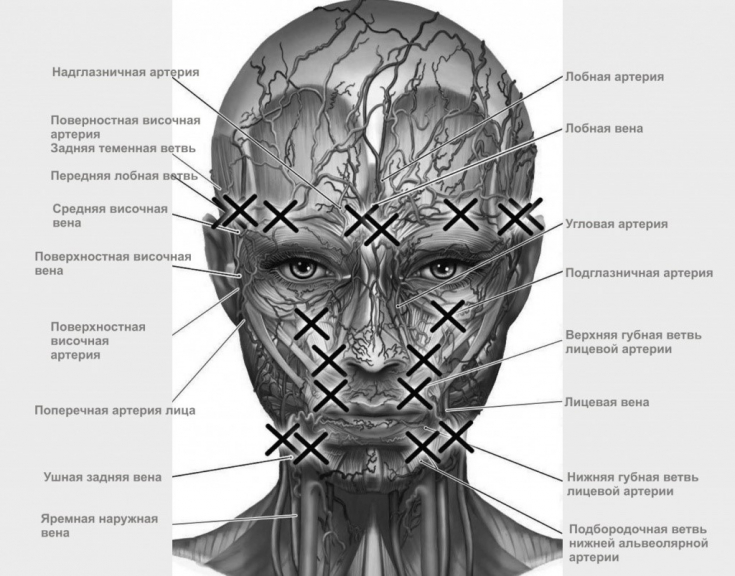Aesthetic skin treatment with injections of hyaluronic acid and botulinum toxin is well established due to safe procedures and stable results. As with any therapy, complications and side effects may occur, depending on the individual factors of each patient, the skill, experience and technique of the specialist. Unpleasant situations associated with the introduction of injections are usually short-term and vary from mild to moderate severity. Proper patient counseling, preparation and flawless technique are the main strategy to reduce the risk of complications.
Botulinum toxin type A injections: basic rules
It is strongly not recommended to use botulinum toxin during pregnancy and breastfeeding due to the lack of adequate data on its effects on the child and the degree of reproductive toxicity.
History before botulinum toxin administration should include allergies, medications taken, chronic illnesses, use of neuromodulators or fillers before. It should be clearly assessed whether this patient has contraindications and risk factors for the occurrence of complications.
In order to reduce the risk of bruising and ecchymosis, it would be helpful to advise avoiding the use of dietary supplements and drugs that can affect blood clotting approximately one week prior to the procedure.
Proper counseling of patients is critical as they must be fully aware of all possible risks, complications and side effects. The patient must understand the entire treatment process and the possibility of potential complications sufficiently to give informed consent to the administration of botulinum toxin.
Follow us on Instagram!
It must be reminded that aesthetic injections are serious medical procedures, so any side effects, complaints, unforeseen changes that are of concern should be reported. These may include non-standard side effects such as drooping of the eyelids or eyebrows, inadvertent change in smile due to paresis of the large and small zygomatic muscles, the muscle that lowers the lip, and the muscle of laughter. Some of these complications can be corrected by injecting botulinum toxin into muscles – antagonists. In cases of droopy eyelids, alpha-adrenergic receptor stimulating ophthalmic solutions may be used to elevate the upper eyelid by contracting the Müller muscle.
Read also: Management of complications after botulinum toxin administration
To minimize pain, it is recommended to use a slow injection technique with a gentle and slow extrusion speed. Vibration anesthesia is effective in reducing the pain of injections.
Hyaluronic acid injections in clinical practice
Risk factors identified during prospective patient counseling may include complication history associated with soft tissue fillers, previous procedures, poor periodontal hygiene, presence of immunodeficiency, recurrent herpes simplex virus type 1 with manifestations on the face, decompensated diabetes mellitus. Patients with autoimmune diseases should be individually assessed on a case-by-case basis, however this is not an absolute contraindication for hyaluronic acid administration.
Read also: Hyaluronic acid injections: application features
Patients should be instructed to inform about the appearance of nodules, both immediately after injection and delayed.
This may indicate incorrect placement of the filler, an individual reaction, an attached infection.
Although vascular occlusion is rare, patients should be aware of all possible symptoms of this complication, including visual disturbances, tissue necrosis, non-thrombotic embolism pulmonary artery.

Fig.1 Dangerous zones when injecting fillers
It is very important to restore the circulation of the retinal vessels within 60-90 minutes. Patients should consent in advance to the destruction of the injected filler using hyaluronidase injections in case of complications.
Read also: Use of hyaluronidase for complications
Follow us on Facebook!
The use of anticoagulants and non-steroidal anti-inflammatory drugs increases the risk of bruises and ecchymosis.
Injection of hyaluronic acid should not be recommended for pregnant women and patients under 18 years of age, as well as in the presence of inflammatory and infectious processes on the face.
Fillers with hyaluronic acid are not used in one procedure with laser treatment, deep chemical peeling, dermabrasion. The use of topical and oral retinoids is not contraindicated.
Injections of filler should be given slowly, with minimal injection pressure and constant movement of the needle in the same plane, to minimize accidental intravascular placement.
Read also: Central Retinal Artery Occlusion: Complication Management
To minimize the risk of bacterial infection, it is recommended to use technique ANTT - Aseptic Non -Touch Technique.
Deep understanding of anatomy, perfect injection techniques, awareness of potential complications, both by the patient and specialist, will allow to minimize risks unfavorable outcome of the procedure, achieve the desired result and improve compliance in further work with the client.
More interesting stuff on our YouTube channel:







Add a comment